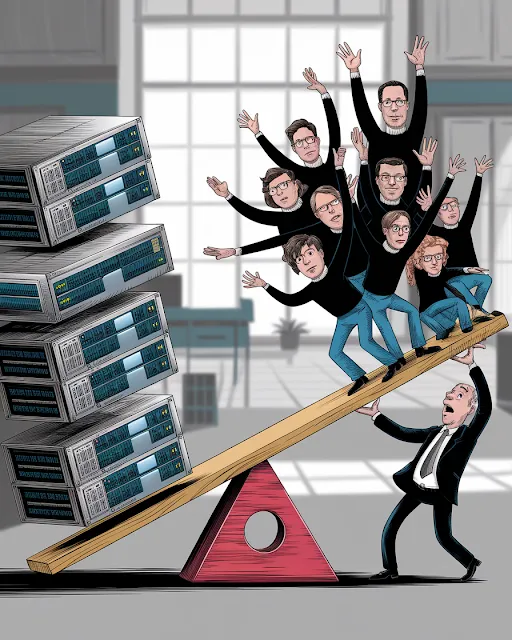Right now, OpenAI dominates the GenAI conversation much like Apple did in the early days of the Mac and iPhone—an exclusive, high-cost, high-curation model with strict control over its product lifecycle. This approach works brilliantly in the short term, creating the illusion of scarcity-driven value and a premium user experience. But in the long run, the cracks in this model start to show.
Let’s look at three fundamental weaknesses of OpenAI’s current trajectory:
1. A Structural Bottleneck: Over-Reliance on Search and Static Training
OpenAI's most urgent problem is its full dependence on internet search to provide users with up-to-date knowledge. At first glance, this might seem like an advantage—it makes ChatGPT appear "live" and relevant. But in reality, it's a massive strategic liability for several reasons:
- Search is an external dependency – OpenAI doesn’t own the sources it retrieves from (Google, Bing, or specialized databases). It relies on external search engines to provide live information, making it vulnerable to restrictions, pricing models, or even direct competition from search providers.
- No native "live" knowledge – Unlike a web page, which can be continuously updated, OpenAI's LLMs are static snapshots of past knowledge that require expensive retraining cycles. The entire foundation of large-scale AI training rules out true live data incorporation on a broad basis. Even at an extreme cost, the current AI paradigm cannot "learn" and evolve in real-time without external inputs like search.
- This is the exact opposite of scalability – Any company fully dependent on external search providers is, by definition, not in control of its own future. It is bound by the business models, pricing, and availability of those external services.
2. The Scaling Wall: OpenAI is Too Capital-Intensive to be Sustainable
OpenAI’s entire infrastructure is built around high-cost, high-burn compute scaling. This means that every major leap in AI performance requires:
- More expensive GPUs (mostly NVIDIA, creating a supply chain bottleneck).
- More data center expansions (forcing partnerships with Microsoft, which owns the cloud infrastructure).
- More capital from investors to keep up with ever-growing compute demands.
These aren’t signs of an infinitely scalable business model; they are classic symptoms of an unsustainable growth loop. Right now, OpenAI’s external capital requirements are staggering—it constantly needs to raise billions just to keep up with increasing model complexity.
This is the same trap that Apple avoided with the App Store and developer ecosystem—instead of shouldering all the growth themselves, they opened up their platform to external value creation, allowing third-party developers to expand the iPhone’s reach far beyond what Apple could do alone.
OpenAI has not yet taken this step. Instead, it remains locked in an arms race with itself, competing on model size and training cycles rather than network effects and platform leverage.
3. The Business Model Misalignment: AI Shouldn't Be a Walled Garden
OpenAI's business model still hasn't evolved from its origins as a research lab. It sells AI like a product, rather than enabling AI as a platform.
Consider the economic differences:
- A product-based AI model requires continuous internal innovation and huge infrastructure spending just to keep existing customers engaged. This is what OpenAI is doing today—a model where only OpenAI can train, refine, and monetize its core technology.
- A platform-based AI model would empower businesses, schools, hospitals, and municipalities to build their own AIs, continuously improving without centralized bottlenecks.
The OpenAI model is not scalable because it is centralized. It creates a singular point of failure where all intelligence must be built, refined, and deployed only through OpenAI's proprietary systems.
This is exactly the weakness that Android exploited to outgrow iOS—by empowering an entire industry rather than restricting it to one company’s vision.
A Better Path: AI as a Decentralized, Federated Network
Now let’s imagine an alternative. What if the next great AI company wasn't trying to own all intelligence, but rather enable its decentralized growth?
The winning model for AI in the long run is not centralized LLMs, but rather an ecosystem of independent, specialized, real-time learning systems that can grow, adapt, and sustain themselves without constant retraining and search dependencies.
This is where a company like Mistral AI could completely disrupt the space—not by competing head-to-head with OpenAI's compute arms race, but by outgrowing OpenAI through scale.
How? By Turning AI into a Franchise Model
Mistral AI (or any ambitious competitor) could do what OpenAI won’t:
- "Franchise" its operational model instead of hoarding AI capabilities. The company itself wouldn’t be the sole provider—it would act as the enabler of thousands of independent AI entities, similar to how WordPress enabled millions of websites to flourish without central control.
- Enable organizations to build their own mini-LLMs that are domain-specific and constantly updated in real-time. Every hospital, municipality, school, and business produces a unique stream of constantly shifting data that is vital for decision-making. Why rely on a distant, centralized LLM trained on outdated data when localized models could provide superior real-time insights?
- Create an AI network, not a monolith – Instead of one gigantic model that tries to answer everything, imagine thousands of interconnected, specialized LLMs, each optimized for its specific domain. These models wouldn’t need constant retraining because they would evolve in real-time within their respective domains.
The Future: Who Will Build the AI Movement?
History teaches us that platforms outgrow products. OpenAI is still treating AI as a product, but the next dominant AI company will treat AI as a network movement.
This is the moment when the AI industry decides whether to repeat the mistakes of closed ecosystems or unlock true scalability by embracing distributed, real-time AI models owned by everyone—not just a handful of companies.
The opportunity is massive. The only question is: Who will take the leap and build it? 🚀

Komentáře
Okomentovat